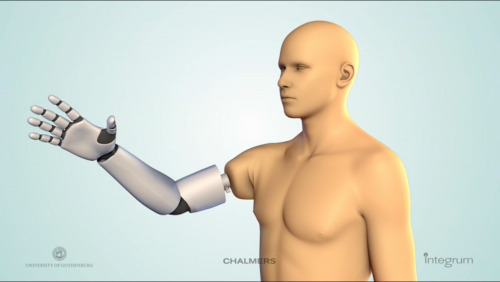1782 posts
World Premiere Of Muscle And Nerve Controlled Arm Prosthesis

World premiere of muscle and nerve controlled arm prosthesis
For the first time an operation has been conducted, at Sahlgrenska University Hospital, where electrodes have been permanently implanted in nerves and muscles of an amputee to directly control an arm prosthesis. The result allows natural control of an advanced robotic prosthesis, similarly to the motions of a natural limb.
A surgical team led by Dr Rickard Brånemark, Sahlgrenska University Hospital, has carried out the first operation of its kind, where neuromuscular electrodes have been permanently implanted in an amputee. The operation was possible thanks to new advanced technology developed by Max Ortiz Catalan, supervised by Rickard Brånemark at Sahlgrenska University Hospital and Bo Håkansson at Chalmers University of Technology.
“The new technology is a major breakthrough that has many advantages over current technology, which provides very limited functionality to patients with missing limbs,” says Rickard Brånemark.
Big challenges There have been two major issues on the advancement of robotic prostheses: 1) how to firmly attach an artificial limb to the human body; 2) how to intuitively and efficiently control the prosthesis in order to be truly useful and regain lost functionality.
“This technology solves both these problems by combining a bone anchored prosthesis with implanted electrodes,” said Rickard Brånemark, who along with his team has developed a pioneering implant system called Opra, Osseointegrated Prostheses for the Rehabilitation of Amputees.
A titanium screw, so-called osseointegrated implant, is used to anchor the prosthesis directly to the stump, which provides many advantages over a traditionally used socket prosthesis.
“It allows complete degree of motion for the patient, fewer skin related problems and a more natural feeling that the prosthesis is part of the body. Overall, it brings better quality of life to people who are amputees,” says Rickard Brånemark.
How it works Presently, robotic prostheses rely on electrodes over the skin to pick up the muscles electrical activity to drive few actions by the prosthesis. The problem with this approach is that normally only two functions are regained out of the tens of different movements an able-body is capable of. By using implanted electrodes, more signals can be retrieved, and therefore control of more movements is possible. Furthermore, it is also possible to provide the patient with natural perception, or “feeling”, through neural stimulation.
“We believe that implanted electrodes, together with a long-term stable human-machine interface provided by the osseointegrated implant, is a breakthrough that will pave the way for a new era in limb replacement,” says Rickard Brånemark.
The patient The first patient has recently been treated with this technology, and the first tests gave excellent results. The patient, a previous user of a robotic hand, reported major difficulties in operating that device in cold and hot environments and interference from shoulder muscles. These issues have now disappeared, thanks to the new system, and the patient has now reported that almost no effort is required to generate control signals. Moreover, tests have shown that more movements may be performed in a coordinated way, and that several movements can be performed simultaneously.
“The next step will be to test electrical stimulation of nerves to see if the patient can sense environmental stimuli, that is, get an artificial sensation. The ultimate goal is to make a more natural way to replace a lost limb, to improve the quality of life for people with amputations,” says Rickard Brånemark.
-
 pleasurehunter2000 liked this · 4 years ago
pleasurehunter2000 liked this · 4 years ago -
 t1ncan reblogged this · 9 years ago
t1ncan reblogged this · 9 years ago -
 scstech-blog reblogged this · 9 years ago
scstech-blog reblogged this · 9 years ago -
 thentheysaidburnher liked this · 11 years ago
thentheysaidburnher liked this · 11 years ago -
 blackimages-blog liked this · 11 years ago
blackimages-blog liked this · 11 years ago -
 littl3sparr0w reblogged this · 11 years ago
littl3sparr0w reblogged this · 11 years ago -
 mrfortesoulexe reblogged this · 11 years ago
mrfortesoulexe reblogged this · 11 years ago -
 pecospecos reblogged this · 11 years ago
pecospecos reblogged this · 11 years ago -
 daileygenevieve liked this · 11 years ago
daileygenevieve liked this · 11 years ago -
 schifnimrod liked this · 11 years ago
schifnimrod liked this · 11 years ago -
 abra-abra--cadaver reblogged this · 11 years ago
abra-abra--cadaver reblogged this · 11 years ago -
 anardana liked this · 11 years ago
anardana liked this · 11 years ago -
 chaos-under-construction reblogged this · 11 years ago
chaos-under-construction reblogged this · 11 years ago -
 receptacle reblogged this · 11 years ago
receptacle reblogged this · 11 years ago -
 joilieder liked this · 11 years ago
joilieder liked this · 11 years ago -
 yellew liked this · 11 years ago
yellew liked this · 11 years ago -
 willbraham reblogged this · 11 years ago
willbraham reblogged this · 11 years ago -
 internetsmiternet-blog reblogged this · 11 years ago
internetsmiternet-blog reblogged this · 11 years ago -
 westerosbaptistchurch liked this · 12 years ago
westerosbaptistchurch liked this · 12 years ago -
 kaluslad liked this · 12 years ago
kaluslad liked this · 12 years ago -
 helenruthofficial liked this · 12 years ago
helenruthofficial liked this · 12 years ago -
 karppy reblogged this · 12 years ago
karppy reblogged this · 12 years ago -
 mooncat-meow-meow liked this · 12 years ago
mooncat-meow-meow liked this · 12 years ago -
 applebutterbomb liked this · 12 years ago
applebutterbomb liked this · 12 years ago -
 karppy liked this · 12 years ago
karppy liked this · 12 years ago -
 lenxo liked this · 12 years ago
lenxo liked this · 12 years ago -
 giffirt reblogged this · 12 years ago
giffirt reblogged this · 12 years ago -
 neonstaar liked this · 12 years ago
neonstaar liked this · 12 years ago -
 peippo reblogged this · 12 years ago
peippo reblogged this · 12 years ago -
 peippo liked this · 12 years ago
peippo liked this · 12 years ago -
 awesomesciencestuff liked this · 12 years ago
awesomesciencestuff liked this · 12 years ago -
 grandmapancakes liked this · 12 years ago
grandmapancakes liked this · 12 years ago -
 pawkiest reblogged this · 12 years ago
pawkiest reblogged this · 12 years ago -
 insaneandscatterbrained reblogged this · 12 years ago
insaneandscatterbrained reblogged this · 12 years ago -
 elegysforsale reblogged this · 12 years ago
elegysforsale reblogged this · 12 years ago -
 mothmann reblogged this · 12 years ago
mothmann reblogged this · 12 years ago -
 stoptheverse-blog liked this · 12 years ago
stoptheverse-blog liked this · 12 years ago -
 streifi reblogged this · 12 years ago
streifi reblogged this · 12 years ago
More Posts from Themanfromnantucket
having separate continents is so stupid im over it reblog if you miss pangaea
Take two?
Twinkle twinkle little star,
How I wonder what you are.
Magnet-fields and plasma all
Rolled up in a giant ball.
Twinkle twinkle little star,
Science taught us what you are.
~
Hey messier51, is that better? If it's not, please tell me; astronomy isn't my forte. I just did some quick reading on Wikipedia.
twinkle twinkle little star,
how i wonder what you are
it’s a flaming ball of gas,
learn some science you dumbass



Mechanical Beasts
Gorgeous mechanical insect and arachnid creations made from recycled watch parts, by Justin Gershenson-Gates (A Mechanical Mind)






